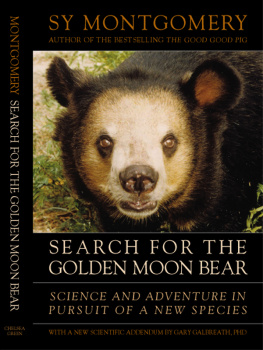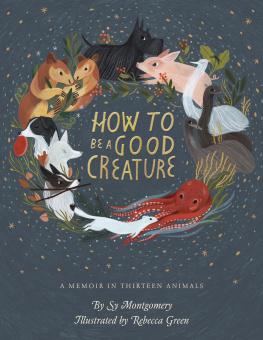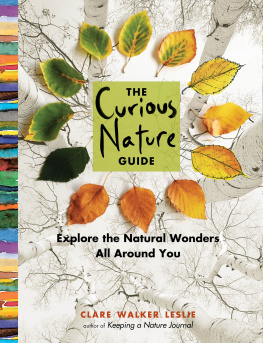Selected Bibliography
Mammals
Good ridge, Harry and Lew Dietz. A Seal Called Andre. Camden, Me.: Down East Books, 1975.
Gorman, Martyn L. and Stone, David R. The Natural History of Moles. Ithaca, NY: Cornell University Press, 1990.
King, Carolyn. The Natural History of Weasels and Stoats. London: Christopher Helm, 1989.
Kinkead, Eugene. Squirrel Book. New York: EP Dutton, 1980.
Langford, Cameron. The Winter of the Fisher. New York: Norton, 1971.
Mellanby, Kenneth. The Mole. London: Collins, 1971.
Nowak, Ronald M. and Paradiso, John L., editors. Walters Mammals of the World, 4th Edition, Volumes I and II. Baltimore: Johns Hopkins Press, 1983.
Rue, Leonard Lee III. The Deer of North America. New York: The Lyons Press, 1997.
Ryden, Hope. Gods Dog: The North American Coyote. New York: Coward, McCann, and Geoghegan, 1975.
Stokes, Don and Lillian. A Guide to Animal Tracking and Behavior. Boston: Little, Brown, 1986.
Thomas, Elizabeth Marshall. The Hidden Life of Dogs. Boston: Houghton Mifflin, 1993.
Wishner, Lawrence. Eastern Chipmunks: Secrets of their Solitary Lives. Washington DC: Smithsonian Press, 1982.
Plants
Bland, John H. Forests ofLilliput: The Realm of Mosses and Lichens. Englewood Cliffs, NJ: Prentice-Hall, 1971.
Darwin, Charles. Insectivorous Plants. London: John Murray, 1875.
Dwelley, Marilyn J. Summer and Fall Wildflowers of New England. Camden, Me.: Down East Books, 1977.
Elias, Thomas S. and Dykeman, Peter A. Field Guide to North American Edible Wild Plants. New York: Van Nostrand Reinhold Company, 1982.
Going, Maud. With the Trees. New York: Baker and Taylor, 1905.
Kavasch, E. Barrie. Enduring Harvests. Old Saybrook, Conn.: Globe Pequot Press, 1995.
Sanders, Jack. Hedgemaids and Fairy Candles: The Lives and Lore of North American Wildflowers. Camden, Me: Ragged Mountain Press, 1993.
Soule, Deb. The Roots of Healing. Secacus, NJ: Carol Publishing Group, 1995.
Stein, Sarah. Planting Noahs Garden. Boston: Houghton Mifflin, 1997.
Stirling, Dorothy. The Story of Mosses, Ferns and Mushrooms. New York: Doubleday, 1955.
Sumner, Judith. The Natural History of Medicinal Plants. Portland, Or.: Timber Press, 2000.
Wallner, Jeff and DiGregorio, Mario. New Englands Mountain Flowers: A High Country Heritage. Missoula, Montana: Mountain Press Publishing Co., 1997.
Birds
Bodio, Stephen J. Aloft. New York: Lyons and Burford Publishers, 1990.
Clark, Neal. Birds on the Move: A Guide to New Englands Avian Invaders. Unity, Me.: North Country Press, 1988.
Forbush, Edward Howe. A Natural History of American Birds. Boston: Houghton Mifflin, 1925.
Heinrich, Bernd. The Mind of the Raven. New York: Cliff Street Books, 1999.
. Ravens in Winter. New York: Simon and Schuster, 1989.
Kaufman, Kenn. Lives of North American Birds. Boston: Houghton Mifflin, 1996.
Kilham, Lawrence. On Watching Birds. Chelsea, Vt.: Chelsea Green, 1988.
. The American Crow and The Common Raven. College Station, Tx.: Texas A&M University Press, 1989.
Stokes, Donald and Lillian. A Guide to Bird Behavior. Volumes I and II. Boston: Little, Brown and Company, 1983.
Wiberg, Hugh. Hand-Feeding Wild Birds. Pownal, Vt.: Storey Books, Annedawn Publishing, 1999.
Insects
Brewer, Jo and Winter, Dave. Butterflies and Moths: A Companion to Your Field Guide. New York: Prentice Hall, 1986.
Buchmann, Stephen L. and Nabhan, Gary Paul. The Forgotten Pollinators. Washington DC: Island Press, 1996.
Dixon, Royal and Eddy, Brayton. Personality of Insects. New York: Henry Holt, 1924.
Evans, Arthur V. and Bellamy, Charles L. An Inordinate Fondness for Beetles. New York: Henry Holt and Company, Inc. 1996.
Holland, W.J. The Moth Book. New York: Doubleday, 1903.
Pyle, Robert Michael. Chasing Monarchs: Migrating with the Butterflies of Passage. Boston: Houghton Mifflin, 1999.
Sargent, Theodore. Legion of Night: The Underwing Moths. Amherst, Ma: University of Massachusetts Press, 1976.
Stokes, Donald. A Guide to Observing Insect Lives. Boston: Little, Brown and Company, 1983.
Winter, Dave. Butterfly Gardening. The Xerces Society with the Smithsonian Institution. San Francisco: Sierra Club Books/Washington DC: National Wildlife Federation, 1990.
Geology
Allport, Susan. Sermons in Stone. New York: W. W. Norton, 1990.
Eckert, Alan W. The Northeastern Quadrant. New York: Harper & Row, 1987.
Raymo, Chet and Maureen E. Written in Stone: A Geological History of the United States. Chester, Ct.: Globe Pequot Press, 1989.
Roberts, David D. A Field Guide to Geology: Eastern North America. Boston: Houghton Mifflin (Peterson Field Guides) 1996.
Trefil, James S. A Scientist at the Seashore. New York: Macmillan, 1984.
Wessels, Tom. The Granite Landscape: A Natural History of Americas Mountain Domes, from Acadia to Yosemite. Woodstock, Vt.: Countryman Press, 2001.
Aquatic and Marine Creatures
Carroll, David M. The Year of the Turtle: A Natural History. Charlotte, Vt: Camden House Publishing, 1991.
, Swampwallkers Journal. Boston: Houghton Mifflin, 1999.
Carson, Rachel. The Edge of the Sea. Boston: Houghton Mifflin, 1955.
Morgan, Ann Haven. Field Book of Ponds and Streams. New York: Putnam, 1930.
Essays
Anderson, Charles R., Editor. Thoreau s World: Miniatures from His Journal. New York: Prentice Hall, 1971.
Duensing, Edward and Millmoss, A.B. The Backyard and Beyond. Golden, Co: Fulcrum, 1992.
Kulish, John. Bobcats Before Breakfast. Harrisburg Pa: Stackpole, 1969.
Rezendez, Paul. The Wild Within. Berkley Publishing Group, 1999.
Shepherd, Odell, Editor. Thoreau s Journals. New York: Dover, 1961.
Thoreau, Henry David. Thoreau: A Wee\ on the Concord and Merrimac\ Rivers; Walden; The Maine Woods; Cape Cod. New York: Library of America, 1985.
Zajonc, Arthur. Catching the Light: The Entwined History of Light and Mind. New York: Oxford University Press, 1993.
Moss
First Mercy of the Earth
I hey bask in frigid snowmelt like a sunbather soaks up sun on a beach. Before the ferns uncoil, before the tree-buds burst, before the jack-in-the-pulpit thrusts its way through the ice, these humble, tiny plants glow green.
Meek creatures, as the 18th-century British art critic John Ruskin called them, the first mercy of the earth, mosses prove again the prophesy that the meek shall inherit the earth, for at the first stroke of spring, the world is theirs. Spring quickens first in the mosses.
Yet those of us who dont know better pass by these lovely plants. Mosses are small and tend to grow in humble places, between the cracks in sidewalks, in the crevices of tree bark, on the underside of rocks. People dont see them, laments Benito Tan, a Harvard Herbarium researcher who monitors the worlds endangered mosses.
Tan admits that he, too, overlooked the mosses at first. As a young botanist in the Philippines, he studied the showier ferns and fern allies, lugging a heavy plant press on his collecting expeditions and returning further weighted down with specimens. An opportunity to study mosses in Canada offered an epiphany: I quickly found that if I go collecting, I come back with only a small bag. The specimens are so light!
The mosses miniature charms won him over. Tan also teaches evening classes for the Arnold Arboretum and New England Wild Flower Society on identifying New England mosses. His message: Although theyre small, theyre so beautiful.
A l0x magnifying lens will help you appreciate the lilliputian world of the mosses. Their fanciful common names suggest their staggering variety of form: The humpbacked elves, greenish-black mosses that look like mushrooms; knights plume, whose light yellow-green feather-like leaves clothe decaying logs; the torn veil mosses of waterfalls; the common hairy cap, the most common moss of Boston woods, named for the hairy, hood-like veil that covers its spore case. It grows in beds that may stretch a hundred feet across.












